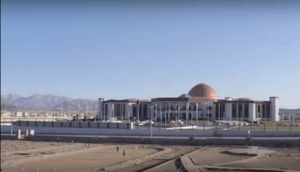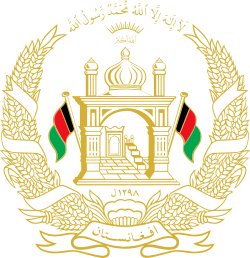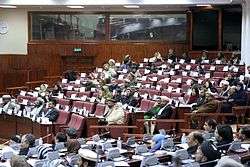National Assembly (Afghanistan)
| National Assembly of the Islamic Republic of Afghanistan[1] د افغانستان د اسلامی جمهوري دولت ملي شوری شورای ملی دولت جمهوری اسلامی افغانستان | |
|---|---|
 | |
| Type | |
| Type | |
| Houses |
Meshrano Jirga (House of Elders) Wolesi Jirga (House of the People) |
| Leadership | |
Speaker of Wolesi Jirga | |
Speaker of Meshrano Jirga |
Fazel Hadi Muslimyaar |
| Seats | 352 members (Wolesi Jirga: 249, Meshrano Jirga: 103) |
| Meeting place | |
| Kabul | |
| Website | |
|
wj mj | |
 |
|---|
| This article is part of a series on the politics and government of Afghanistan |
|
Government |
The National Assembly (Pashto: ملی شورا Mili Shura, Persian: شورای ملی Shura-e Milli), also known as the Afghanistan Parliament,[2] is Afghanistan's national legislature. It is a bicameral body, comprising two chambers:
- Meshrano Jirga (Pashto: مشرانوجرګه)) or the House of Elders: an upper house with 102 seats.
- Wolesi Jirga (Pashto: ولسي جرګه) or the House of the People: a lower house with 250 seats.
According to Chapter Five of the Constitution of Afghanistan, "the National Assembly of the Islamic Republic of Afghanistan as the highest legislative organ is the manifestation of the will of its people and represents the whole nation. Every member of the National Assembly takes into judgment the general welfare and supreme interests of all people of Afghanistan at the time of casting their vote".[3]
The National Assembly is located in south-western Kabul, across the ruined Darul Aman Palace.[4]. The current building for the Assembly was built with Indian assistance and inaugurated in late 2015 by Prime Minister of India Narendra Modi and Afghan President Ashraf Ghani.[5]
Duties of the National Assembly
Ratification, modification or abrogation of laws or legislative decrees; Approval of social, cultural, economic as well as technological development programs; Approval of the state budget as well as permission to obtain or grant loans; Creation, modification and or abrogation of administrative units; Ratification of international treaties and agreements, or abrogation of membership of Afghanistan in them; Other authorities enshrined in this Constitution.
The Wolesi Jirga (House of People)
The Wolesi Jirga has 250 seats with members directly elected by the people. Sixty-eight women were elected to the seats reserved under the Constitution, while 17 of them have been elected in their own rights. Each province was given proportionate representation in the Wolesi Jirga according to its population. Each member of the Wolesi Jirga will enjoy a five-year term.
An aspiring candidate for the Wolesi Jirga must fulfill the following criteria:
- Be at least 25 years of age
- Be a citizen of Afghanistan
- Be registered as a voter
- Be running as a representative in only one province
- Pay a registration fee of 15,000 Afghanis (approximately US$300) which will be refunded provided the candidate wins at least three percent (3%) of the vote
- Submit a nomination form along with photocopies of 500 voter ID cards supporting the candidacy
In addition, no candidate can have been charged with crimes against humanity.
The Meshrano Jirga (House of Elders)
The Meshrano Jirga consists of a mixture of appointed and elected members (total 102 members). Sixty-eight members were selected by 34 directly elected Provincial Councils, and 34 were appointed by the President. President Karzai’s appointments were vetted by an independent UN sponsored election board and included 17 women (50%), as required by the Constitution.
Each provincial council has elected one council member to serve in the Jirga (34 members), also each district council (34 members). Representatives of provincial councils will serve a term of four years, while representatives of district councils will serve a term of three years. Sebghatulla Mojadeddi was appointed President of Meshrano Jirga.
An aspiring candidate for the Meshrano Jirga must fulfill the following criteria:
- Be at least 35 years of age
- Be a citizen of Afghanistan
In addition, no potential member of the Meshrano Jirga can have been charged with crimes against humanity.[6]
Construction of the new Parliament building

The foundation stone for the new Afghan Parliament was laid in August 2005 by the last king of Afghanistan, Zahir Shah, in the presence of Hamid Karzai and Manmohan Singh.[7] India's Central Public Works Department (CPWD) was the consultant for the project and the contract was awarded to an Indian infrastructure company in 2008.[8] The new Parliament building is corralled in an 84-acre plot in Darulaman on the outskirts of Kabul and fringes such historical landmarks as Amanullah Khan's Palace and the Queen's Palace.
The construction work on the building was initially slated to be complete by 2012, in 36 months. The deadline, however, was pushed back due to challenging work conditions, shortage of skilled workforce and precarious security environment. More than 500 laborers had worked on the building, most of them Indian nationals. The main attraction of the building is a bronze dome of 32 meter diameter and 17.15 meter height is considered to be the largest dome in Asia. The big dome will cover the assembly hall and the small dome will be over the entrance lobby. In front of the building, there is a water body with nine cascading fountains. Inside the building, a 20-feet fountain, made of green marble imported from Indian city of Udaipur, has been installed.[4]
On December 25, 2015, during a state visit of Indian Prime Minister Narendra Modi, the new Parliament building was inaugurated along with President Ashraf Ghani.[9][10] Ghani tweeted: "Pleased to welcome PM Modi to Kabul. Though, India & Afghanistan need no introduction, we are bound by a thousand ties... We have stood by each other in the best and worst of times."
See also
References
- ↑ http://www.parliament.af/
- ↑ "Afghan parliament halts debate on women's rights law". BBC News. 18 May 2013. Retrieved October 29, 2014.
- ↑ "Chapter Five – The National Assembly". afghan-web.com. 2004. Retrieved October 29, 2014.
- 1 2 "Afghanistan New Parliament building gifted by INDIA Afghanistan's closest ally". Tolo TV. December 23, 2015. Retrieved February 1, 2016.
- ↑ "PM Narendra Modi, Ashraf Ghani inaugurate new parliament building in Kabul". India. December 25, 2015. Retrieved February 1, 2016.
- ↑ "Archived copy". Archived from the original on 2016-11-06. Retrieved 2016-11-06.
- ↑ Siddharth Varadarajan, ed. (August 30, 2005). "Democracy not the preserve of the West: Karzai". The Hindu. Retrieved October 29, 2014.
- ↑ "MEA | Photo Features : Photos". mea.gov.in. Retrieved 2016-01-04.
- ↑ "Modi inaugurates new Afghan Parliament built by India in Kabul". hindustantimes.com. Retrieved 2016-01-04.
- ↑ "PM Modi inaugurates the new Parliament building of Afghanistan". India. December 25, 2015. Retrieved 2016-01-04.